Of all the guitar scales you’ll dive into, the pentatonic scale is highly likely to become a firm favorite. For decades, this scale has been the backbone of countless iconic guitar solos and is the ideal starting point for crafting your own improvisational melodies.
Like most scales, the pentatonic scale is derived from the major scale. The prefix “penta” signifies five, hinting that this scale is built upon just five notes. These five notes are obtained by simplifying the major scale, specifically by removing its fourth and seventh degrees.
By omitting these two notes, we refine some of the more harmonically complex intervals within the major scale. This simplification grants you greater freedom and flexibility when improvising and soloing. You’ll find yourself less concerned about hitting a wrong note, allowing for more expressive and fluid playing.
Ready to Elevate Your Guitar Skills? 🎸
Discover a faster way to learn your favorite songs with Guitareo’s interactive practice tools, available within our members’ area. Kickstart your musical journey with a 7-day free trial today!
TRY GUITAREO
The initial video lessons in this guide are excerpted from our comprehensive 12-part Lead Guitar Quick-Start Series. If you’re eager to explore other essential lead guitar techniques such as vibrato, bending, and additional scales, this series will be your best resource. Let’s begin with our first lesson focusing on the major pentatonic scale.
The Major Pentatonic Scale: Shape 1
Pentatonic scales primarily come in two forms: the major pentatonic scale and the minor pentatonic scale. We’ll start by examining the major pentatonic scale.
Mastering the shape of the major pentatonic scale requires some finger dexterity as it involves using all four fingers in varied patterns across the guitar strings. Begin slowly, focusing on learning the pattern one string at a time. Below is the complete diagram for a G major pentatonic scale in its first position:
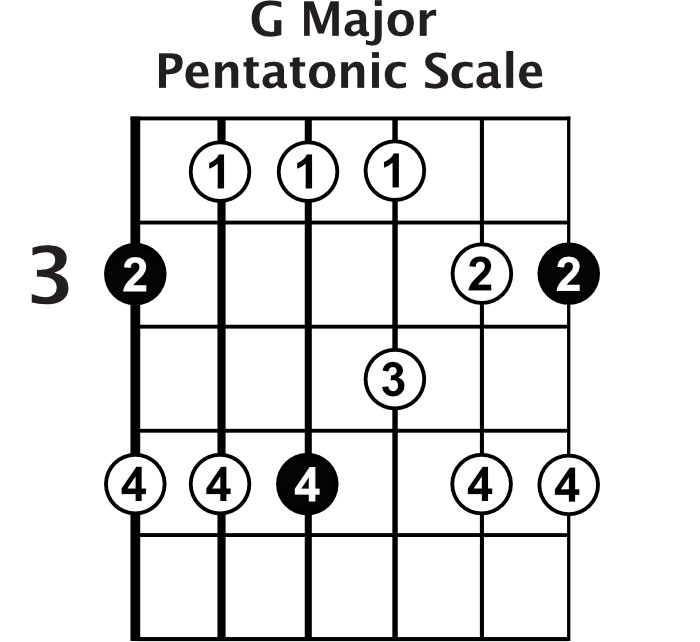 G Major Pentatonic Scale Shape 1
G Major Pentatonic Scale Shape 1
For those unfamiliar with the concept of root notes, the black circles in the diagram indicate the ‘G’ notes within the scale. These root notes are fundamental as they give the scale its name. Therefore, in the context of a G major pentatonic scale, the root notes are Gs.
Using the root notes (black circles) as your starting reference, you’ll notice that the five notes of the scale repeat a little over two times, spanning nearly two and a half octaves.
To aid your practice, we’ve included a jam track to play along with while learning this scale. This makes internalizing the shape more engaging and transforms potentially tedious scale practice into a more enjoyable musical experience!
Unlocking the Minor Pentatonic Scale: Shape 1
The second variation of the pentatonic scale is the minor pentatonic scale. This scale shape is often favored, especially when you start venturing into guitar solos. Its popularity stems from its inherent simplicity and versatility.
The six-string shape of the minor pentatonic scale is composed of just two distinct finger patterns. This simplicity makes it incredibly accessible to get under your fingers and commit to memory. Here’s the diagram for the G minor pentatonic scale, shape 1:
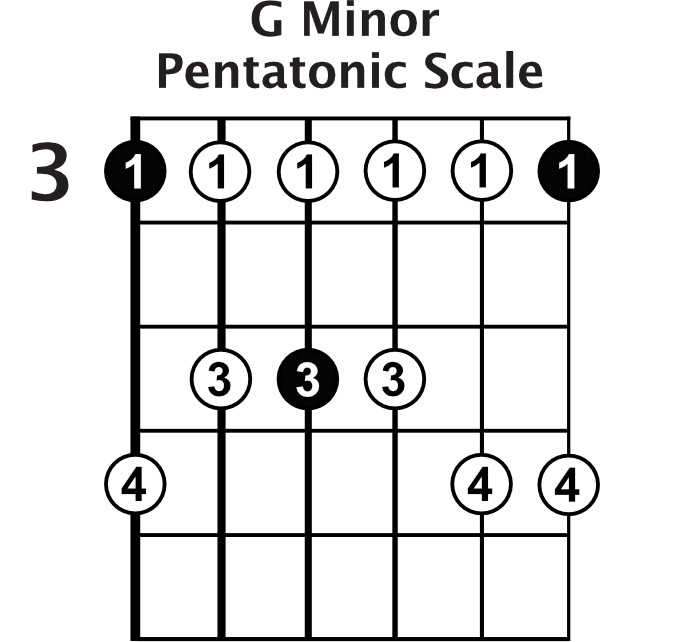 G Minor Pentatonic Scale Shape 1
G Minor Pentatonic Scale Shape 1
As you can see, the minor pentatonic scale in this first shape begins on the same fret as the major pentatonic shape we looked at earlier, but employs a different pattern of notes. One scale (major pentatonic) is derived from the key of G major, while the other (minor pentatonic) comes from the key of G minor.
Download the provided jam track and practice this minor pentatonic scale shape along with it. Becoming comfortable with both the major and minor pentatonic shapes in their first positions is recommended before progressing further in this guide.
Mastering the 5 Essential Pentatonic Scale Shapes
By this stage, you should be acquainted with two out of the five fundamental pentatonic scale shapes. These five shapes, when combined, cover a span of twelve frets before the patterns begin to repeat, and they are all interconnected across the fretboard.
A helpful way to visualize this is to imagine all the possible locations across the fretboard where you can play the five notes of the pentatonic scale. When you piece these locations together, you discover five unique shapes within a twelve-fret range.
Shape #1 (Major Pentatonic): The first shape should already be familiar from our earlier discussion of the major pentatonic scale. This first position of the major pentatonic scale is based around an E major chord shape (in open position). Comparing the scale diagram to the E major chord shape, you can see how they overlay each other. The scale incorporates all the notes of the chord and adds a few more that fit within the key.
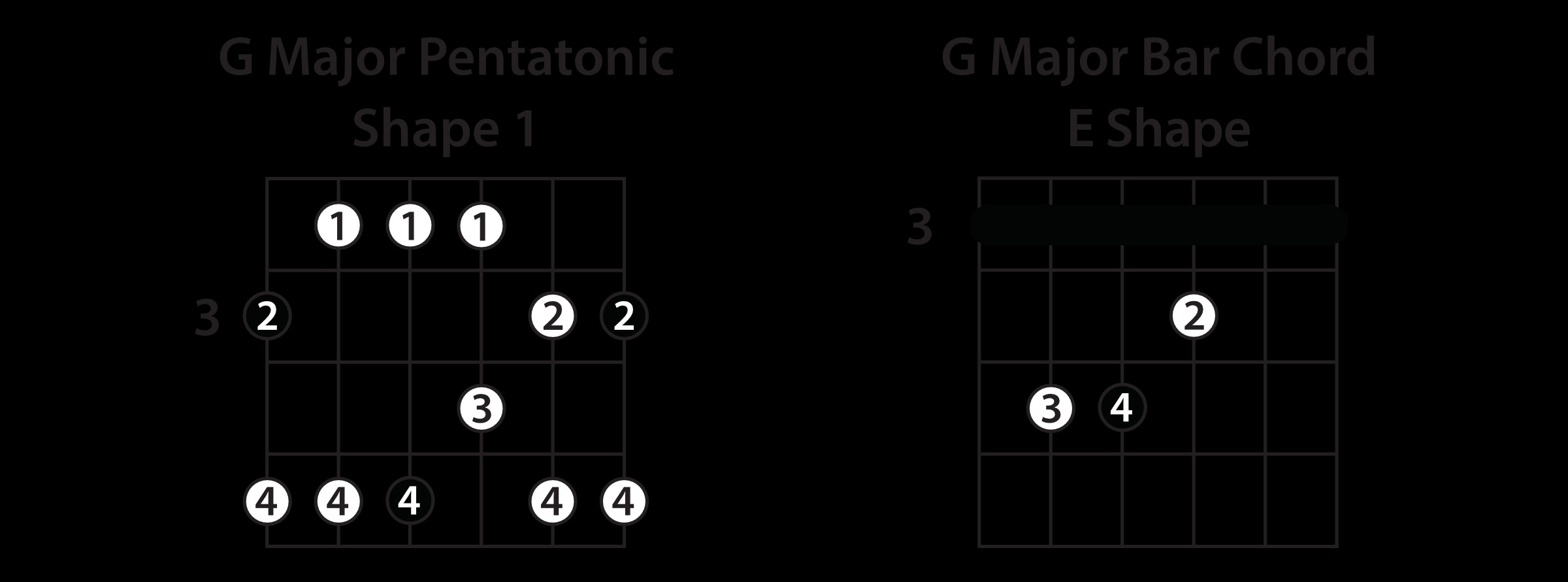 Pentatonic Scale Shape 1
Pentatonic Scale Shape 1
It’s beneficial to try and visualize chord shapes when you’re examining scale shapes. This connection aids in memorizing the scale patterns and also helps you quickly identify the root notes within each shape.
Shape #2 (Major Pentatonic): Moving to the second shape, you’ll notice it starts right where the first shape concludes. Pay attention to the root notes in this shape, and you’ll observe that the scale shape neatly outlines a D major shaped barre chord (when played at the 10th fret for G major).
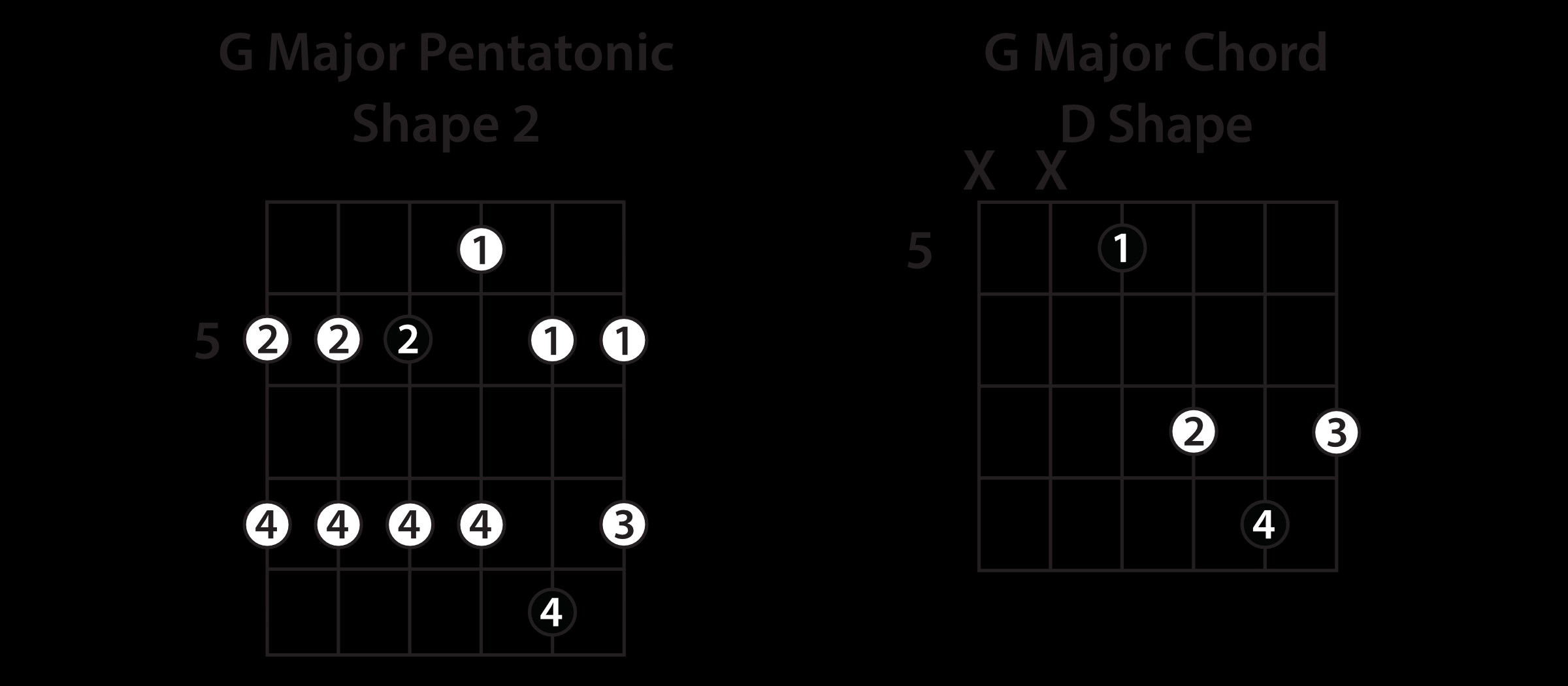 Pentatonic Scale Shape 2
Pentatonic Scale Shape 2
As you progress from one shape to the next, focus on how each shape transitions into the subsequent one. As your guitar skills develop, you’ll naturally begin to move fluidly between these shapes, rather than remaining confined to a single position.
Shape #3 (Major Pentatonic): Continuing up the fretboard, the third pentatonic shape emerges, and this one corresponds to a C major shaped barre chord (at the 8th fret for G major). Remember, each shape is simply a different segment of the same five-note scale, repeated in different octaves across the fretboard. The ‘G’ notes are still marked as black circles, as we are still exploring the G major pentatonic scale.
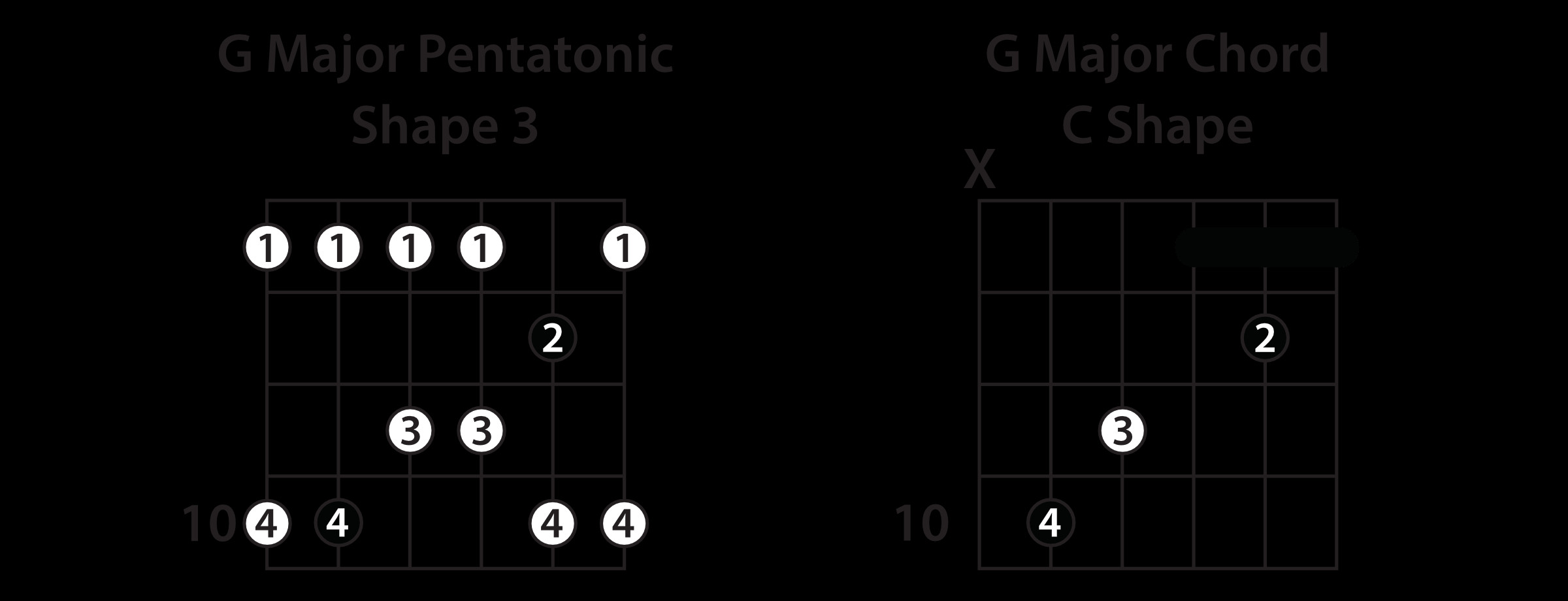 Pentatonic Scale Shape 3
Pentatonic Scale Shape 3
Shape #4 (Major Pentatonic): Here’s another shape that’s easy to memorize because of its symmetrical pattern. It features only two finger patterns across the six strings and closely aligns with your standard A major shaped barre chord (at the 5th fret for G major). As with the previous shapes, be sure to observe the connection points between shape #3 and shape #4.
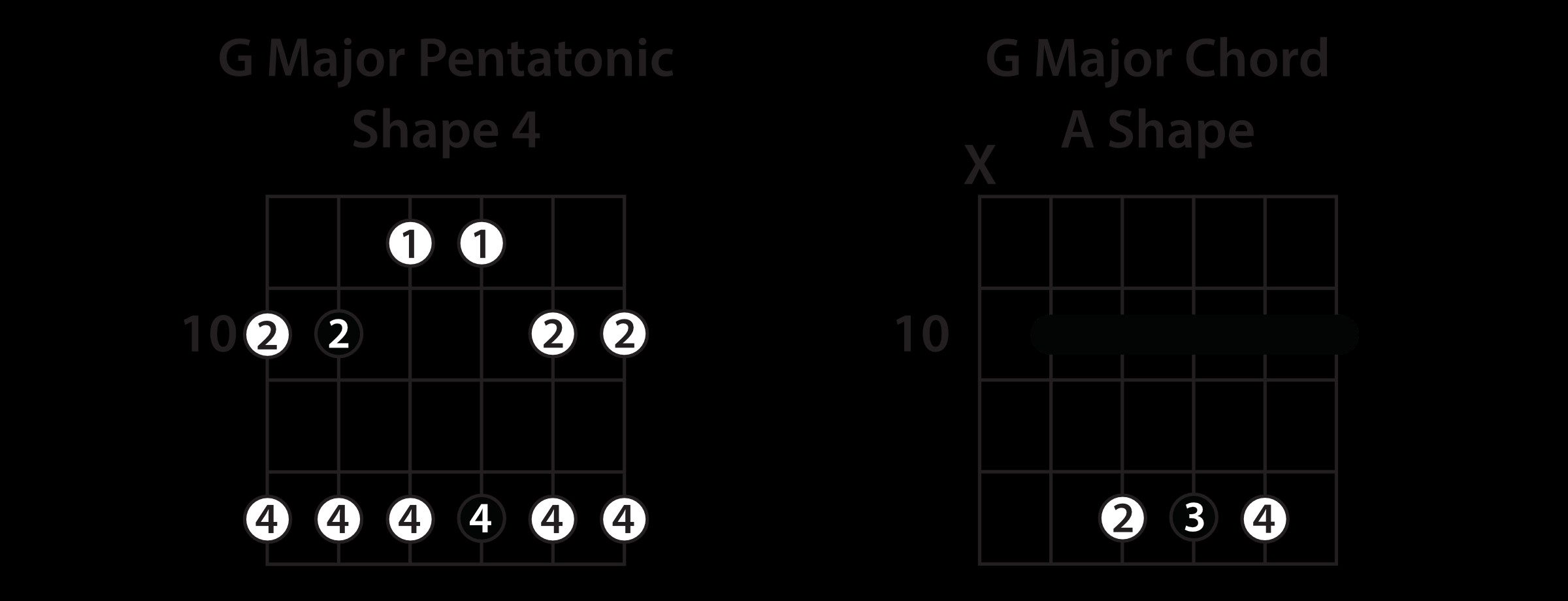 Pentatonic Scale Shape 4
Pentatonic Scale Shape 4
Shape #5 (Major/Minor Pentatonic): You might be wondering where the minor pentatonic scale shape fits into this sequence of major pentatonic shapes. The minor pentatonic shape actually corresponds to the fifth and final shape in this connected series. While it might visually differ slightly from the G minor scale shape we initially looked at (which was in the 3rd fret position), this is because that earlier shape was specifically a G minor pentatonic scale, whereas here we are still examining the major pentatonic context. The G major version of this fifth shape outlines a standard G major chord (in open position).
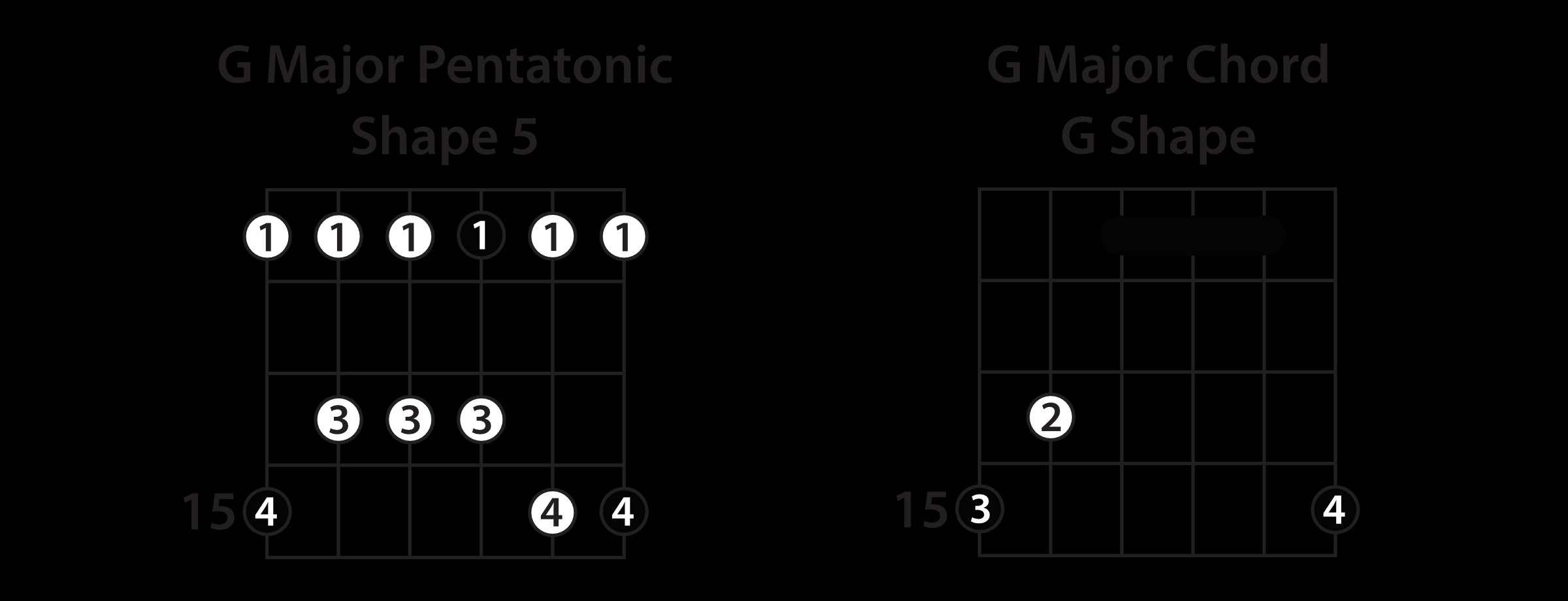 Pentatonic Scale Shape 5
Pentatonic Scale Shape 5
Understanding the Relationship Between Major and Minor Pentatonic Scales
Depending on your familiarity with music theory, you might already know about major and minor keys and their interrelation. If this is a new concept, here’s a concise explanation.
Every major key has a corresponding relative minor key. This relative minor key shares the exact same seven notes as its related major key. To find the relative minor key, you simply identify the sixth note of a major scale. That sixth note becomes the root note of the relative minor key. In the key of G major, the sixth note is E. If you start the same set of notes on E, you construct an E minor scale. Here’s the breakdown:
G Major Scale: G A B C D E F#
Sixth Note: E
E Minor Scale: E F# G A B C D
As you can see, both scales contain the identical notes. Consequently, they also share the same set of chords. This is why we use the term “relative.” This major and minor relationship directly translates to pentatonic scales.
Therefore, the five G major pentatonic shapes we’ve explored are, in fact, the very same five shapes as the E minor pentatonic scale. The only distinction lies in which note you consider the root. In the case of E minor pentatonic, you would emphasize the ‘E’ notes as the root, rather than the ‘G’ notes.
Here’s an E minor pentatonic scale diagram. Notice that it’s precisely the same shape and location as the fifth G major pentatonic shape we just covered:
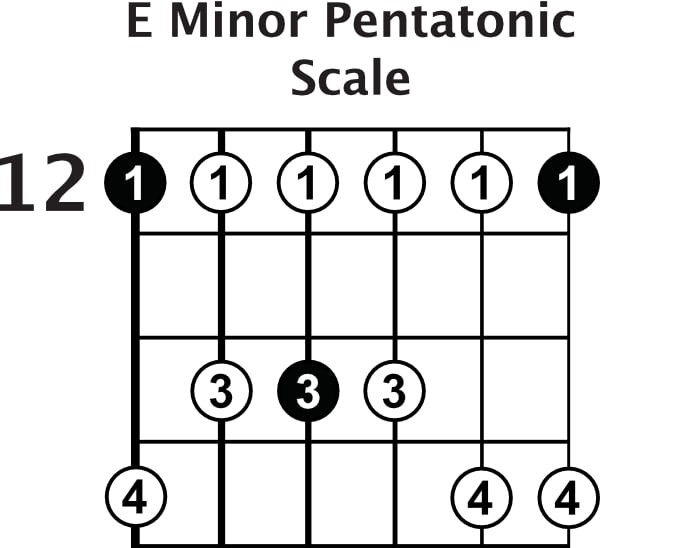 E Minor Pentatonic Scale
E Minor Pentatonic Scale
When playing the minor pentatonic scale, it’s advisable to emphasize the root notes of the relative minor key, rather than the root notes of the major key. This means focusing on the E notes more intentionally than the G notes when you are composing your solos, crafting lead lines, or improvising.
And that concludes this guide to playing pentatonic scales on the guitar! You now have a solid understanding of all the major and minor pentatonic scale shapes and their relationship. This knowledge is just the starting point of your lead guitar journey, with many more exciting concepts to explore. Continue scrolling for more guitar lessons focused on the pentatonic scale to further your learning.
Explore More Guitar Lessons You’ll Love!
Pentatonic Navigation Tips
You’ve learned the pentatonic shapes, but how do you connect them seamlessly to emulate your guitar heroes? This lesson with Nate Savage reveals the pathways between pentatonic scale shapes.
Minor Pentatonic Magic
Embark on a journey into the minor pentatonic scale with Ayla Tesler-Mabe. Discover tips and techniques to break free from the pentatonic box and improvise solos with greater emotion and expression.
A Guide To Improvising Guitar Solos
Transform from a beginner to a guitar soloist with this comprehensive guide to improvising guitar solos. Start with a simple scale shape and progress to creating your own original solos on the spot!
Want to accelerate your guitar skill development? Unlock our interactive practice tool and learn from inspiring instructors within the Guitareo members’ area. Click the green button below to begin your 7-day free trial today:
TRY GUITAREO FOR 7 DAYS
SHARE THIS:
 Andrew Clarke Profile Picture
Andrew Clarke Profile Picture

